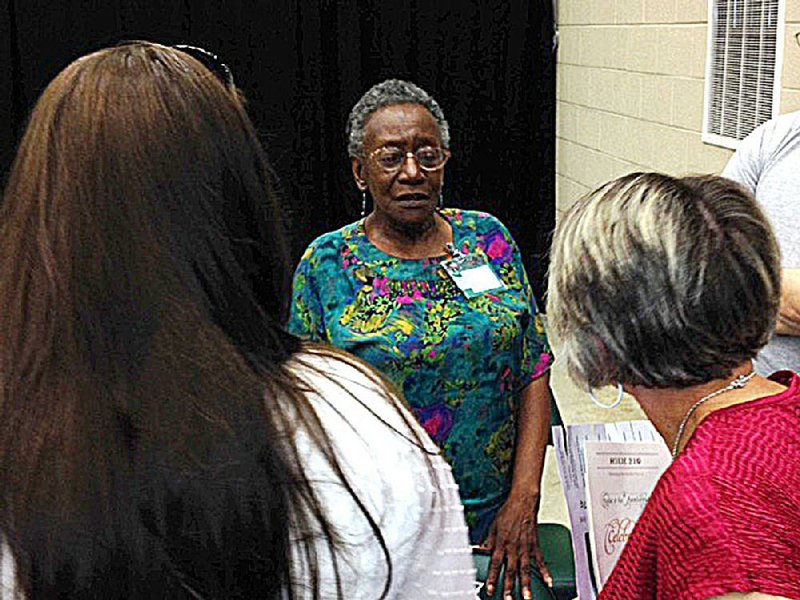HOXIE -- They didn't realize when walking through the doors of Hoxie's schools 60 years ago Saturday that the students would become part the history of the South's integration.
Twenty-one students entered the school July 11, 1955, after the 1954 U.S. Supreme Court decision on school integration. In the summer of 1954 in Arkansas, Charleston and Fayetteville both integrated schools quietly with little turmoil and no press coverage.
Hoxie's integration went differently.
Fayth Hill-Washington was a fourth-grade student when she first attended Hoxie Elementary School that July day and didn't have the perspective she has now. "I was just being obedient to my parents," said Hill, 68, of West Memphis. "They told me I needed to go.
"I was grown before I realized we made history."
For Ethel Tompkins, the first black student to graduate from the integrated school system, attending the new school after going to Hoxie Colored Elementary School was an adventure.
"We now had indoor bathrooms, water fountains, a library and the [classroom] seats weren't falling apart," said Tompkins, 71, of Hoxie.
About 200 gathered in the Hoxie High School gymnasium Saturday to celebrate the 60th anniversary of the schools' integration and to announce the intent to build a museum honoring the occasion. During the event, promoters showed a documentary about the schools and the current Hoxie School Board voted to support the 1955 board's unanimous decision to integrate.
Former students spoke of their experiences.
"Things that are worth doing aren't necessarily easy," said U.S. Rep. Rick Crawford, R-Ark., during the celebration. "It wasn't easy for those parents to say, 'We're going to take our kids to a white school and leave them.'
"The right thing to do is the right thing to do always," he said.
At first, the integration went smoothly. Twenty-one of the 25 black students who were originally enrolled in the school district went to the formerly white-only schools. Four black students withdrew.
"We knew a lot of the students, anyway," Tompkins said. "It was a better environment to learn. There wasn't any animosity.
"At least at first."
But on July 25, 1955, just two weeks after the 21 black students went to their new schools, Life magazine featured an article about the integration. White supremacists from out of town, called "outsiders" by the locals, flocked to Hoxie to protest the move. They called for a boycott of the school.
Students saw angry opponents at the schoolyard. Hill-Washington remembers being yelled at and called names.
Others said people spit at them and threw rocks. Someone once fired a shot through a black family's house, barely missing two children inside.
Howard Vance, a member of the 1955 all-white Hoxie School Board, said in a 2004 interview with the Arkansas Democrat-Gazette that he received several threatening telephone calls after the board voted to integrate. Vance died in September 2005.
"I could feel the tension at home," Gene Vance, Howard Vance's son, said Saturday. Vance, 68, was 8 years old when his father served on the Hoxie School Board but attended an elementary school in nearby Sedgwick.
"I'm very proud of this," Vance said of his father's actions. "I always thought of him as an older man, well-seasoned. But he was only 40 years old when this happened. My thoughts have been on that decision lately and what the repercussions were.
"This actually set the tone for integration across the South," Vance said. "It wasn't the first school to integrate, but it was the first fight. Without Hoxie, there would never have been the Little Rock integration."
In 1957, federal troops were called to help integrate Little Rock Central High School as nine black students enrolled. Until then, black students couldn't attend Central High.
Howard Vance and the Hoxie School Board voted to close the schools in August 1955 while board members sought an injunction against those favoring segregation. The injunction was granted after the U.S. Department of Justice became involved, and on Oct. 14, 1955, the schools reopened.
Marlyn Tate, 71, of Hoxie, remembered when the black students showed up at his white school. He was a seventh-grader then and knew some of the students because they played together.
"There were no problems. We knew some of the kids already," he said. "Then the outsiders came and stirred things up."
He recalled being in a music class with one black student.
"He could really sing," Tate said of the student. "The rest of us, we'd start singing and get quieter and quieter so we could hear him sing."
Now, 60 years later, some of the students have returned. Hill-Washington began the Hill Foundation to help promote the group, called the "Hoxie 21" and its historical significance.
"This is our legacy," she said. "We can't let it be forgotten."
Tompkins joined the Navy after graduating in 1961 and lived in California for years before returning to Hoxie.
"This taught me to how to be in different situations," she said of the integration while speaking to the crowd Saturday. "My father taught me that I belong anywhere, anytime. I was not intimidated by different things.
"Thank you, Hoxie High School, for preparing me for life."
Lawrence County Chamber of Commerce director Fran Cavenaugh said Saturday that organizers want to build a replica of the old Hoxie Colored Elementary School and feature exhibits inside. The original school, which sat along U.S. 63, was torn down long ago.
"This is a national story that has to be told," she said.
State Desk on 07/12/2015

